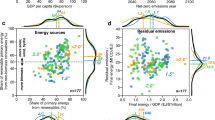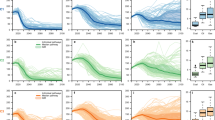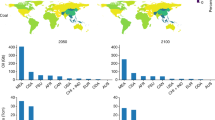Abstract
Under many scenarios, fossil fuels are projected to remain the dominant energy source until at least 2050. However, harder-to-reach fossil fuels require more energy to extract and, hence, are coming at an increasing ‘energy cost’. Associated declines in fossil fuel energy-return-on-investment ratios at first appear of little concern, given that published estimates for oil, coal and gas are typically above 25:1. However, such ratios are measured at the primary energy stage and should instead be estimated at the final stage where energy enters the economy (for example, electricity and petrol). Here, we calculate global time series (1995–2011) energy-return-on-investment ratios for fossil fuels at both primary and final energy stages. We concur with common primary-stage estimates (~30:1), but find very low ratios at the final stage: around 6:1 and declining. This implies that fossil fuel energy-return-on-investment ratios may be much closer to those of renewables than previously expected and that they could decline precipitously in the near future.
This is a preview of subscription content, access via your institution
Access options
Access Nature and 54 other Nature Portfolio journals
Get Nature+, our best-value online-access subscription
$29.99 / 30 days
cancel any time
Subscribe to this journal
Receive 12 digital issues and online access to articles
$119.00 per year
only $9.92 per issue
Buy this article
- Purchase on Springer Link
- Instant access to full article PDF
Prices may be subject to local taxes which are calculated during checkout






Similar content being viewed by others
Data availability
The extended energy input datasets were obtained under licence from the IEA. The IEA World Energy Statistics and Balances can be downloaded with institutional or other user licence from https://doi.org/10.1787/enestats-data-en. The EXIOBASE 3.4 database is available at http://exiobase.eu/index.php/data-download/exiobase3mon. The concordance matrices used in the EXIOBASE-based calculations are available in the associated University of Leeds data repository47. The aggregate EROI datasets generated are available from the corresponding author upon reasonable request.
Code availability
The MATLAB code written for generating EiE in the EROI calculations is available at GitHub at the following link: https://github.com/earao/EROI.
References
Gilliland, M. W. Energy analysis and public policy. Science 189, 1051–1056 (1975).
Odum, H. T. Energy, ecology, and economics. Ambio 2, 220–227 (1973).
Federal Nonnuclear Energy Research and Development Act of 1974 (United States Congress, 1974).
Bullard, C. W., Penner, P. S. & Pilati, D. A. Net energy analysis: handbook for combining process and input–output analysis. Resour. Energy 1, 267–313 (1978).
Mulder, K. & Hagens, N. J. Energy return on investment: toward a consistent framework. Ambio 37, 74–79 (2008).
Kunz, H., Hagens, N. J. & Balogh, S. B. The influence of output variability from renewable electricity generation on net energy calculations. Energies 7, 150–172 (2014).
Gagnon, N., Hall, C. A. S. & Brinker, L. A preliminary investigation of energy return on energy investment for global oil and gas production. Energies 2, 490–503 (2009).
Lambert, J. G. et al. EROI of Global Energy Resources: Status, Trends and Social Implications (GOV.UK, 2013).
IPCC Climate Change 2014: Mitigation of Climate Change (eds Edenhofer, O. et al.) (Cambridge Univ. Press, 2014).
King, L. C. & Van Den Bergh, J. C. J. M. Implications of net energy-return-on-investment for a low-carbon energy transition. Nat. Energy 3, 334–340 (2018).
World Energy Outlook 2017 (IEA, 2017); https://www.iea.org/weo2017.
Sers, M. R. & Victor, P. A. The energy-missions trap. Ecol. Econ. 151, 10–21 (2018).
Hall, C. A. S., Balogh, S. & Murphy, D. J. R. What is the minimum EROI that a sustainable society must have? Energies 2, 25–47 (2009).
Fizaine, F. & Court, V. Energy expenditure, economic growth, and the minimum EROI of society. Energy Policy 95, 172–186 (2016).
Hall, C. A. S., Lambert, J. G. & Balogh, S. B. EROI of different fuels and the implications for society. Energy Policy 64, 141–152 (2014).
Brand-Correa, L. I. et al. Developing an input–output based method to estimate a national-level energy return on investment (EROI). Energies 10, 534 (2017).
Cleveland, C. J., Costanza, R., Hall, C. A. S. & Kaufmann, R. Energy use and the US economy: a biophysical perspective. Science 225, 890–897 (1983).
Raugei, M. & Leccisi, E. A comprehensive assessment of the energy performance of the full range of electricity generation technologies deployed in the United Kingdom. Energy Policy 90, 46–59 (2016).
Raugei, M. Net energy analysis must not compare apples and oranges. Nat. Energy 4, 86–88 (2019).
IPCC Climate Change 2013: The Physical Science Basis (eds Stocker, T. F. et al.) (Cambridge Univ. Press, 2013).
Capellán-Pérez, I. et al. Global Model: MEDEAS-World Model and IOA Implementation at Global Geographical Level (MEDEAS, 2017); https://www.medeas.eu/system/files/documentation/files/Deliverable%204.1%20%28D13%29_Global%20Model.pdf
Dale, M., Krumdieck, S. & Bodger, P. Global energy modelling—a biophysical approach (GEMBA) part 1: an overview of biophysical economics. Ecol. Econ. 73, 152–157 (2012).
Fagnart, J. F. & Germain, M. Net energy ratio, EROEI and the macroeconomy. Struct. Change Econ. Dyn. 37, 121–126 (2016).
King, C. W. & Hall, C. A. S. Relating financial and energy return on investment. Sustainability 3, 1810–1832 (2011).
Court, V. & Fizaine, F. Long-term estimates of the energy-return-on-investment (EROI) of coal, oil, and gas global productions. Ecol. Econ. 138, 145–159 (2017).
Guilford, M. C., Hall, C. A. S., Connor, P. O. & Cleveland, C. J. A new long term assessment of energy return on investment (EROI) for U.S. oil and gas discovery and production. Sustainability 3, 1866–1887 (2011).
King, C. W., Maxwell, J. P. & Donovan, A. Comparing world economic and net energy metrics, part 2: total economy expenditure perspective. Energies 8, 12975–12996 (2015).
IEA World Energy Statistics and Balances (IEA, 2017); https://doi.org/10.1787/data-00513-en
Stadler, K. et al. EXIOBASE 3: Developing a time series of detailed environmentally extended multi-regional input–output tables. J. Ind. Ecol. 22, 502–515 (2018).
Brandt, A. R., Dale, M. & Barnhart, C. J. Calculating systems-scale energy efficiency and net energy returns: a bottom-up matrix-based approach. Energy 62, 235–247 (2013).
World Energy Balances: Database Documentation (2018 Edition) (IEA, 2018); http://wds.iea.org/wds/pdf/WORLDBAL_Documentation.pdf
Murphy, D. J., Carbajales-Dale, M. & Moeller, D. Comparing apples to apples: why the net energy analysis community needs to adopt the life-cycle analysis framework. Energies 9, 1–15 (2016).
Palmer, G. An input–output based net-energy assessment of an electricity supply industry. Energy 141, 1504–1516 (2017).
Palmer, G. & Floyd, J. An exploration of divergence in EPBT and EROI for solar photovoltaics. Biophys. Econ. Resour. Qual. 2, 15 (2017).
Barrett, J. et al. Consumption-based GHG emission accounting: a UK case study. Clim. Policy 13, 451–470 (2013).
Owen, A. et al. Energy consumption-based accounts: a comparison of results using different energy extension vectors. Appl. Energy 190, 464–473 (2017).
Bashmakov, I. Three laws of energy transitions. Energy Policy 35, 3583–3594 (2007).
Kilian, L. The economic effects of energy price shocks. J. Econ. Lit. 46, 871–909 (2008).
Aucott, M. & Hall, C. Does a change in price of fuel affect GDP growth? An examination of the U.S. data from 1950–2013. Energies 7, 6558–6570 (2014).
Bauer, N., Baumstark, L. & Leimbach, M. The REMIND-R model: the role of renewables in the low-carbon transformation-first-best vs. second-best worlds. Clim. Change 114, 145–168 (2012).
Bernard, A. & Vielle, M. GEMINI-E3, a general equilibrium model of international–national interactions between economy, energy and the environment. Comput. Manag. Sci. 5, 173–206 (2008).
Clarke, L. et al. in Climate Change 2014: Mitigation of Climate Change (eds. Edenhofer, O. et al.) 413–510 (Cambridge Univ. Press, 2014).
Capellán-Pérez, I., Mediavilla, M., de Castro, C., Carpintero, Ó. & Miguel, L. J. Fossil fuel depletion and socio-economic scenarios: an integrated approach. Energy 77, 641–666 (2014).
Bhandari, K. P., Collier, J. M., Ellingson, R. J. & Apul, D. S. Energy payback time (EPBT) and energy return on energy invested (EROI) of perovskite tandem photovoltaic solar cells. Renew. Sustain. Energy Rev. 47, 133–141 (2015).
Dale, M. & Benson, S. M. Energy balance of the global photovoltaic (PV) industry-is the PV industry a net electricity producer? Environ. Sci. Technol. 47, 3482–3489 (2013).
Cullen, J. M. & Allwood, J. M. Theoretical efficiency limits for energy conversion devices. Energy 35, 2059–2069 (2010).
Brockway, P. E., Owen, A., Brand-Correa, L. I. & Hardt, L. University of Leeds Data Repository Data from: Estimation of global final-stage energy-return-on-investment for fossil fuels with comparison to renewable energy sources. (University of Leeds Data Repository, 2019); https://doi.org/10.5518/598
Miller, R. E. & Blair, P. D. Input–Output Analysis: Foundations and Extensions (Cambridge Univ. Press, 2009).
Brandt, A. R. & Dale, M. A general mathematical framework for calculating systems-scale efficiency of energy extraction and conversion: energy return on investment (EROI) and other energy return ratios. Energies 4, 1211–1245 (2011).
Moeller, D. & Murphy, D. Net energy analysis of gas production from the Marcellus Shale. Biophys. Econ. Resour. Qual. 1, 5 (2016).
Lenzen, M. & Treloar, G. J. Endogenising capital: a comparison of two methods. J. Appl. Input-Output Anal. 10, 1–11 (2004).
Södersten, C. J. H., Wood, R. & Hertwich, E. G. Endogenizing capital in MRIO models: the implications for consumption-based accounting. Environ. Sci. Technol. 52, 13250–13259 (2018).
Chen, G. Q. & Wu, X. F. Energy overview for globalized world economy: source, supply chain and sink. Renew. Sustain. Energy Rev. 69, 735–749 (2017).
Brandt, A. R. Oil depletion and the energy efficiency of oil production: the case of California. Sustainability 3, 1833–1854 (2011).
Raugei, M., Fullana-i-Palmer, P. & Fthenakis, V. The energy return on energy investment (EROI) of photovoltaics: methodology and comparisons with fossil fuel life cycles. Energy Policy 45, 576–582 (2012).
Leccisi, E., Raugei, M. & Fthenakis, V. The energy and environmental performance of ground-mounted photovoltaic systems—a timely update. Energies 9, 622 (2016).
Kubiszewski, I., Cleveland, C. J. & Endres, P. K. Meta-analysis of net energy return for wind power systems. Renew. Energy 35, 218–225 (2010).
Mearns, E. The global energy crisis and its role in the pending collapse of the global economy. The Oil Drum Europe http://theoildrum.com/node/4712 (2008).
Acknowledgements
This research was primarily funded by the UK Energy Research Centre, supported by the UK Research Councils under EPSRC award EP/L024756/1. We also acknowledge support for P.E.B. under EPSRC Fellowship award EP/R024251/1. The contributions of A.O. were also supported by the Centre for Industrial Energy, Materials and Products (EPSRC award EP/N022645/1), and under EPSRC Fellowship award EP/R005052/1. L.I.B.-C. was supported by the Living Well Within Limits project funded by the Leverhulme Trust.
Author information
Authors and Affiliations
Contributions
P.E.B., L.I.B.-C., A.O. and L.H. jointly designed the study and wrote the paper. P.E.B. and L.H. sourced IEA data and undertook calculations to calculate the total energy produced and direct energy consumed. L.I.B.-C. and A.O. performed the MRIO calculations to obtain indirect energy estimates.
Corresponding author
Ethics declarations
Competing interests
The authors declare no competing interests.
Additional information
Publisher’s note: Springer Nature remains neutral with regard to jurisdictional claims in published maps and institutional affiliations.
Rights and permissions
About this article
Cite this article
Brockway, P.E., Owen, A., Brand-Correa, L.I. et al. Estimation of global final-stage energy-return-on-investment for fossil fuels with comparison to renewable energy sources. Nat Energy 4, 612–621 (2019). https://doi.org/10.1038/s41560-019-0425-z
Received:
Accepted:
Published:
Issue Date:
DOI: https://doi.org/10.1038/s41560-019-0425-z
This article is cited by
-
Systemwide energy return on investment in a sustainable transition towards net zero power systems
Nature Communications (2024)
-
Life-cycle assessment to guide solutions for the triple planetary crisis
Nature Reviews Earth & Environment (2023)
-
Reviewing the use of zeolites and clay based catalysts for pyrolysis of plastics and oil fractions
Brazilian Journal of Chemical Engineering (2023)
-
Estimating the Disaggregated Standard EROI of Canadian Oil Sands Extracted via Open-pit Mining, 1997–2016
Biophysical Economics and Sustainability (2023)
-
Recent Advances of Transition Metal Basic Salts for Electrocatalytic Oxygen Evolution Reaction and Overall Water Electrolysis
Nano-Micro Letters (2023)



